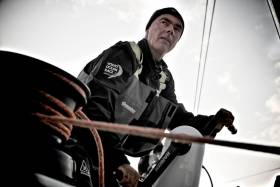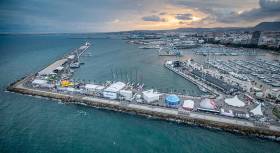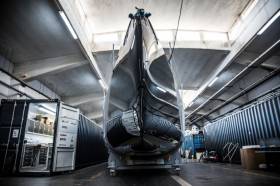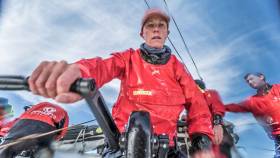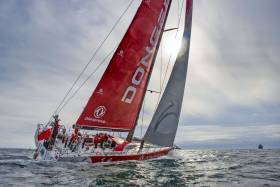Displaying items by tag: VOR
#VOR - Irish sailing photographer and filmmaker Brian Carlin is returning to the Volvo Ocean Race — this time as leader for the fleet’s team of onboard reporters announced at the weekend.
Carlin made his debut in the VOR as the embedded multimedia reporter with Team Vestas Wind, the role offer coming as a surprise to the frequent contributor to Afloat.ie.
It was equally unexpected that he would be on hand to document the team’s disastrous grounding on a shoal in the Indian Ocean.
The Kerryman was nominated for the 2015 Mirabaud Yacht Racing Image of the Year Award for his shot of Vestas Wind’s damaged hull, ultimately coming second in the public vote.
Now Carlin heads a team that comprises some of the finest adventure photographers in the world, including National Geographic contributor Jen Edney; BBC journalist Tom Martienssen; and James Blake, son of VOR winner Sir Peter Blake.
Sam Greenfield joins Carlin as one of two reporters returning from the previous VOR, with the remaining debutants being Konrad Frost from CNN Mainsail, Jeremie Lecaudey from the snowboarding world, experienced sailing photographer Martin Keruzoré, Clipper Race cameraman Richard Edwards, and Spain’s Ugo Fonollá, the team’s youngest member.
Kerry is also represented in the next VOR by Damian Foxall, who will be on deck with Carlin’s old team — now renamed Vestas 11th Hour — as Leg Zero begins today (Wednesday 2 August) with a race around the Isle of Wight as part of Cowes Week.
The pre-race leg to establish the status of teams’ readiness for October’s start will continue from this weekend with the Rolex Fastnet Race, followed by a string of mini-races from Plymouth to St Malo to Lisbon.
Damian Foxall Will Return For Sixth Volvo Ocean Race
#VOR - Experienced offshore sailor and Kerry’s own Damian Foxall will set sail again in the Volvo Ocean Race — this time with the former Team Vestas Wind.
The five-race VOR veteran (who won with Groupama in the 2011-12 race) and Afloat.ie’s International Sailor of the Month for June last year has been named among the 10-strong crew for Vestas 11th Hour Racing that will depart from Alicante less than 100 days from now.
The line-up, comprising six nationalities and six previous VOR winners, includes Simon Fisher — who returns for his fifth edition and first after lifting the trophy as winning navigator with Abu Dhabi Ocean Racing in 2015.
Also on the squad are two-time winner Phil Harmer, who’s hunting a hat-trick of successive victories, and Tony Mutter, who like Foxall is back for his sixth 45,000-nautical-mile lap of the planet.
“It’s amazing to be back in the Volvo Ocean Race with some old acquaintances as well as inspiring new talent,” said Fisher.
“This time we’re focusing on performance, as well as a sponsorship with an important message, backed by two partners, Vestas and 11th Hour Racing, fully committed to making a positive change.
“It’s a privilege to be given the chance and the platform to share the message of sustainability and ocean health. I’ve dodged everything from telegraph poles to old fridge-freezers while at sea. We’ve got to act now, and as a group, this is what we aspire this campaign to be about.”
Others on the Vestas 11th Hour crew include Tom Johnson, fresh from the America’s Cup as part of Team Oracle USA, and two female sailors: Britain’s Hannah Diamond and Jena Mai Hansen, an Olympic medallist for Denmark, both of whom will be racing their first VOR.
“It was actually my first-ever full night at sea - an intimidating but amazing experience,” said Hansen of her recent transatlantic trial. “Helming a Volvo Ocean 65 boat in the middle of the Atlantic in pitch dark, in 40 knots, is without a doubt one of the craziest things I’ve ever done. I’m hungry for more and excited to be part of a skilled, international team. Bring it on!”
Between them, the crew have competed in the VOR over 20 times — and skipper Charlie Enright says that he’s delighted with the preparations with just a few months remaining until the start line.
“We’ve taken our time to get this right, and we couldn’t ask for a better group of sailors,” he said.
The team are currently preparing to travel to Gosport in the UK for pre-race activation and Leg Zero commitments, lining up against the other teams for the first time in the Round-the-Island race during Cowes week, followed by the Rolex Fastnet Race, and finishing up in Lisbon after sailing via St Malo in mid-August.
Last week it was announced that America’s Cup winner Blair Tuke is joining MAPFRE for the 13th Volvo Ocean Race that begins on 14 October.
Bouwe Bekking Returns As Skipper In 2017-18 Volvo Ocean Race
#VOR - The Volvo Ocean Race’s most experienced sailor will return for the 2017-18 edition this autumn when Bouwe Bekking joins Team Brunel for another run around the world.
Bekking is fresh off his stint as tactician with the crew of J Class yacht Lionheart, winners of both the inaugural America’s Cup J Class Regatta — landing them a handmade relief map of Bermuda courtesy of Latitude Kinsale — and the Superyacht Regatta just days before.
The 54-year-old Dutchman made his first appearance in the VOR, then known at the Whitbread Round The World Race, in 1985 as crew on Philips Innovator, which finished second in that race.
Thirty years on — and more miles sailed than any other in the history of the gruelling global offshore challenge — he skippered Dutch entry Team Brunel to that same first-runner-up spot in the 2014-15 edition of the VOR.
He will be looking to break that duck come the 2017-18 edition, which sets sail from Alicante in under four months’ time with a confirmed eight-strong fleet that will its way around the globe to reach The Hague in June 2018.
Bekking also skippers one of four teams returning for a second successive edition, along with Team Vestas Wind, MAPFRE and China’s Dongfeng Race Team.
Volvo Ocean Race Recruiting Race Experts & Watch Officers For Nerve Centre Of Global Yachting Challenge
#VOR - The Volvo Ocean Race has an incredible opportunity for three ambitious sailors to helm the nerve centre of the round-the-world yachting challenge.
Based in Alicante, the role of Race Expert/Watch Officer is the “perfect opportunity” either for very experienced sailors who want to be back in the heart of the Volvo Ocean Race, or young sailors determined to compete in the race in the future.
Key aspects of the job include, in a phased watch-keeping mode whilst the boats are racing:
- Build relationships with each team, via constant communication with the sailing teams at sea and onboard reporters.
- Monitoring of the fleet with the best navigation and weather tools available.
- Analysis and communication of team strategy, supporting wider media and comms team with their high-quality content, and direct and immediate explanations of tactics to the online audience as a Race Expert via various digital channels 24/7.
- Being a first point of contact for emergency incident management, supporting the Crisis Management Team.
If you’re an RYA Offshore Yachtmaster or equivalent, have proven offshore racing experience, know modern yacht racing like the back of your hand, have strong analytical and communication skills, and a deep passion for the sport, you might well be who the VOR is looking for.
But hurry, as the closing date for applications is Sunday 21 May. Full details of the position and job requirements are available as a PDF to read or download HERE.
Team AkzoNobel’s Volvo Ocean Race Yacht Rolls Into Lisbon For Final Fittings Marathon
#VOR - Team AkzoNobel’s brand new Volvo Ocean 65 has made the 2,000km journey from Persico Marine in Italy to The Boatyard in Lisbon.
Staff at the state-of-the-art facility, which began work on the rest of the fleet last October, will see that the sole new build will be fully fitted out for the demands of the Volvo Ocean Race just months away.
“This is an exciting project for us,” said Boatyard head Sam Bourne, who added that more than 20 people will be putting in up to 2,000 man hours between now and mid June to ready the boat for the water.
As previously reported on Afloat.ie, sailing apparel manufacturer Zhik (available from CH Marine in Ireland) was announced as the official technical clothing partner for the new Team AkzoNobel in the upcoming 13th edition of the round-the-world offshore yachting challenge.
While final preparations and team announcements continue for the Volvo Ocean Race 2017-18, the event’s leadership team are working in parallel to map out the race’s future. The edition after this one, the 14th, will be contested in brand new One Design racing yachts designed by France’s Guillaume Verdier and built under the direction of the Persico boatyard in Italy, race organisers announced today.
Verdier has joined the Volvo Ocean Race Design Team and is currently working with the race on the crucial issue of whether the new boat will be a monohull or multihull. The final decision on the proposed designs will be announced on 18 May at an event in Gothenburg, the home of the race’s owners and title sponsors Volvo.
Verdier is the ‘quiet’ achiever who has been involved in most of the leading designs right across the sport in recent years – from giant multihulls like Gitana’s Maxi Edmond de Rothschild, to be launched in July, through Team New Zealand’s current America’s Cup flying multihulls to maxi-monohulls like Comanche, and the leading Vendée Globe IMOCA 60 foiling projects such as Hugo Boss and Banque Populaire VIII.
The monohull-multihull question is just one of a series of key decisions that will be finalised in the coming weeks and announced at the 18 May event in Gothenburg, Sweden. Together, the announcements will form the most radical shake-up of the Volvo Ocean Race since it began life in 1973 as the Whitbread Round the World Race.
“Conceived in 2011, the current fleet of boats was built to be competitive for two editions,” said Volvo Ocean Race CEO Mark Turner. “We need to move now on the future boats to keep all our options open on boat type and design.
“We’re excited to work with someone as talented as Guillaume Verdier – who will be a perfect complement to the wider Volvo Ocean Race Design Team, and the input we plan to have from a wider group of professional sailors and industry partners.”
On the decision to award Persico the lead role in the building of the boats, rather than the Consortium approach used for the Volvo Ocean 65s, Nick Bice, the race’s Chief Technical Development Officer, said: “The Consortium did some good work last time around to produce such matched boats, but we prefer to contract this time with a single builder, who in turn will undoubtedly sub-contract a number of other builders around the world to achieve the build in time and to budget. Persico have been a strong partner over these past few years, and we are delighted to be working with them again.”
The decision to continue with a One Design concept follows the introduction of the Volvo Ocean 65 monohull for the Volvo Ocean Race 2014-15, which produced the closest racing in the history of the event.
The upcoming edition, starting on 22 October 2017 in Alicante, will use the same Volvo Ocean 65 boats that have since undergone a one million euro per boat refit process in the race’s Boatyard facility in Lisbon. These boats were designed to be fast enough and reliable enough to complete at least two laps of the planet at the highest level of professional racing, in a fully competitive and equal state.
The fleet of seven existing boats from 2014-15 will be supplemented by a brand new but still identical Volvo Ocean 65, commissioned by team AkzoNobel, for the 2017-18 race.
With more than six months still to go before the start, four teams have so far been announced. The remaining teams will be revealed over the coming months.
The race opted to go with Verdier after inviting input from half a dozen industry-leading yacht designers, including Farr Yacht Design, the team that kick-started the One Design era in the race by delivering the successful Volvo Ocean 65 project.
Verdier’s goal will be to lead the Volvo Ocean Race Design Team to build a new fleet to the same exacting levels of matched One Design achieved with the current boats, but very much connected to the big evolutions in foiling technology the world of sailing is currently seeing.
“We’re bringing together a wide-ranging depth of experience from events such as the America’s Cup, offshore multihulls and IMOCA Open 60 projects,” Verdier explained.
“We are starting from a blank page, and whatever kind of boat we design, whether it’s monohull or multihull, we will learn a lot from this process of working together.”
He continued: “I think sailors just want to have fun, and are attracted to a new way of sailing. In the Open 60, for example, we made something which was quite radical, but also very safe, and that’s key for the Volvo Ocean Race.”
Marcello Persico said the company was delighted to be building the next generation of Volvo Ocean Race boats.
“We’ve been working closely with the Volvo Ocean Race for the last eight years and we feel part of the family,” he said. “I believe that Persico Marine will deliver excellent support and service to the Volvo Ocean Race as it embarks on the next phase in its history.”
Women Join Dongfeng Crew For 2017-18 Volvo Ocean Race
#VOR - Dongfeng Race Team has announced two women for its crew as preparations ramp up for the 2017-18 Volvo Ocean Race.
Dutch Olympic sailor Carolijn Brouwer, who competed in the previous VOR with the all-female Team SCA, will be joined by France’s Marie Riou, a fellow Olympian and a multi-time Nacra 17 world champion.
They will sail alongside previously announced crew members Jérémie Beyou, Stu Bannatyne and Daryl Wislang under returning skipper Charles Caudrelier for the Chinese entry that secured third place in its first VOR in 2014-15.
Caudrelier said Brouwer was a given for his crew “because she beat us many times during the last race when she helmed Team SCA in the in-port races.
“We all knew that she is a good helm and she has a big Olympic past and I really respect that. But her Olympic campaigns have turned her into a very fast driver and she knows where to put the boat.”
Riou, meanwhile, brings a wealth of Olympic sailing and offshore racing experience to the team, along with her strength and “good spirit”, the skipper added.
Brouwer and Riou’s selection marks the first move under last year’s rule change to encourage mixed crews in the next edition of the race, as previously reported on Afloat.ie.
It’s not the only first for Dongfeng, which last month released footage of its refitted Volvo Ocean 65 in testing off Lisbon — where the race fleet is being readied at the VOR’s Boatyard facility ahead of the race start in seven months’ time.
An eighth boat is in the final stages of construction at Persico Marine in Italy for new campaign Team AkzoNobel.
Drone Footage Of Dongfeng’s Refitted Volvo Ocean Race Contender
#VOR - Dongfeng Race Team is back on the water and training is well underway for the returning Chinese campaign in the 2017-18 Volvo Ocean Race less than eight months away.
To mark the occasion, some incredible drone footage of the refitted Volvo Ocean 65 has been released as the team hit the water off the coast of Lisbon.
As the remaining boats continue to undergo the €1-million refit process, Charles Caudrelier is the first skipper out on the water with his upgraded Volvo Ocean Race challenger.
The French skipper has yet to announce his sailing squad for the next edition of the race, but the team have said it will once again feature a mixed Chinese and western crew — and will also take advantage of new rules designed to encourage female sailors to take part.
Caudrelier has been working hard for months on this new campaign that he hopes will build on the team’s impressive third place on debut in the Volvo Ocean Race in 2014-15.
Dongfeng Race Team are backed by Dongfeng Motor Corporation, one of the largest automobile manufacturers in China.
Refit Completed On Dongfeng’s VOR Challenger
#VOR - Dongfeng Race Team’s Volvo Ocean 65 is the first boat to emerge from its refit process ahead of this year’s Volvo Ocean Race.
The VOR website has details of the boat’s €1 million overhaul at Lisbon’s Boatyard, which has seen more than 500 items on board either augmented or upgraded.
Due for launch today (Tuesday 17 January), the boat must first undergo a rigorous commissioning and calibration regime to optimise its new electronics, deck gear and rigging before it can set sail with skipper Charles Caudrelier and crew on board for their first training sessions.
#VOR - The 2017-18 Volvo Ocean Race will begin less than a year from now on Sunday 22 October, when the starting gun is fired in Alicante and the teams set out to complete a total of 45,000 nautical miles of offshore racing, over a course that takes in 11 landmark cities in five continents over eight months.
Organisers have also revealed the start dates for the first three legs of ‘sailing’s longest and toughest adventure’, rounding off a series of 10 major announcements on the future of the VOR over the past two weeks.
The first official action of the 2017-18 edition will be the Alicante in-port race on Saturday 14 October before the race proper begins eight days later with Leg 1, a 700nm sprint to Lisbon that also marks the fourth consecutive start from the race’s home port.
After arriving in Lisbon, the boats will take part in the in-port race on Saturday 28 October before the start of Leg 2 on Sunday 5 November.
That leg will see them battle it out over three-plus weeks and 7,000nm of the Atlantic Ocean to Cape Town, the 11 occasion in 13 editions that the Volvo Ocean Race has visited the South African city.
The Cape Town in-port race will take place on Friday 8 December and Leg 3 will begin two days later on Sunday 10 December.
VOR organisers say the decision to tweak the format of race weekends at many of the stopovers by moving the in-port race from the Saturday to the Friday gives teams an extra 24 hours to prepare for the rigours of ocean racing to come.
“With just a year to go, the countdown to the Volvo Ocean Race 2017-18 has begun,” said VOR chief executive Mark Turner. “The sailors can look forward to an unforgettable send-off from Alicante, our home port, and the fact that they’ll be thrown into a high intensity sprint to Lisbon straight off will make Leg 1 especially exciting.
“Our Boatyard facility is based in Lisbon, and it will be very well known to teams who will use it as an Atlantic training base in the lead-up to the start.”
Turner added: “Cape Town also has a special connection with the Race – our boats have been heading there since the very first edition, back in 1973 – so there will be a lot that is very familiar before the teams head towards the Southern Ocean, which is such an important focus for the race.”
The full route, including almost three times the amount of Southern Ocean sailing as in recent editions, was announced earlier this year. Organisers will announce dates for the rest of the legs in the coming weeks.





























